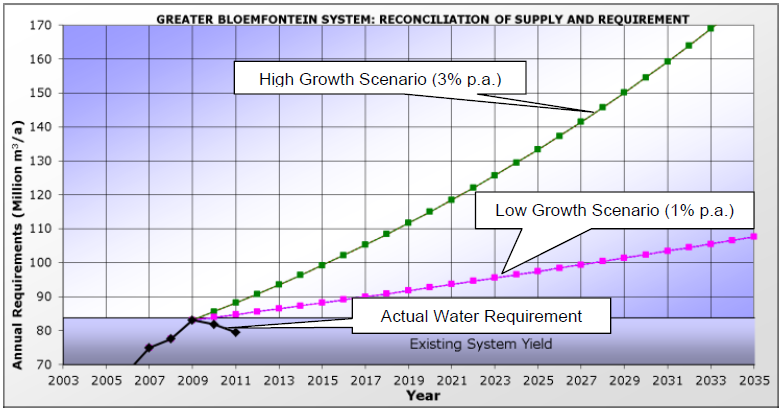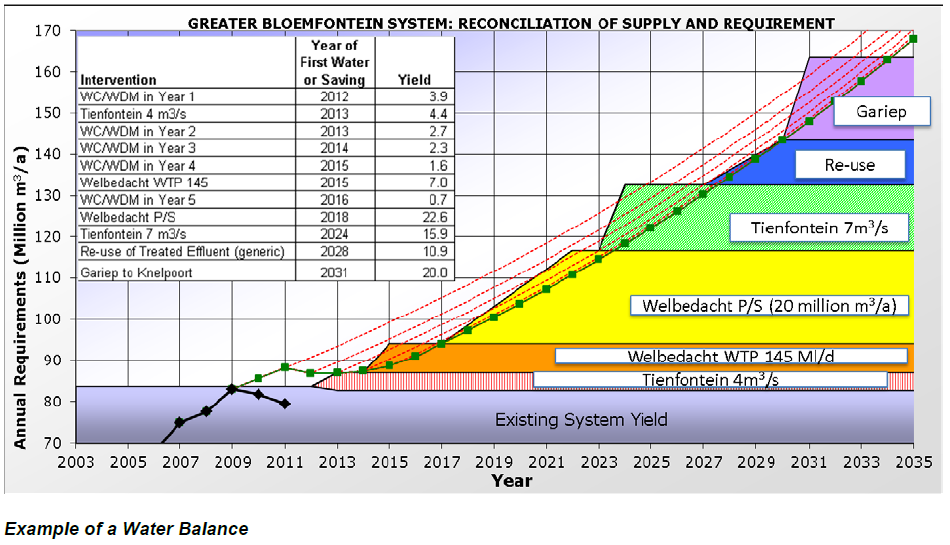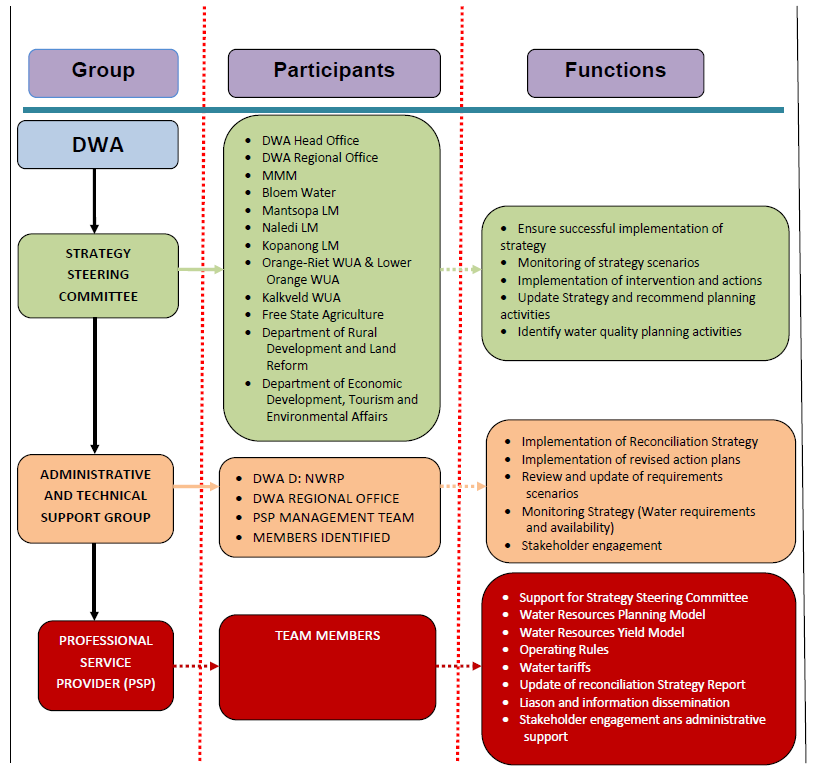|
Purpose of the Strategy
The purpose of the Reconciliation Strategy is to determine the current water
balance situation and to develop various possible future water balance scenarios
up to 2035 and beyond. This entails an analysis of current and future water
requirements, an understanding of all of the issues which could impact on the
reconciliation of supply and requirement and knowledge of possible future
interventions which can be used to reconcile supply and requirement, both WC/WDM
interventions and supply side interventions. One of the biggest issues affecting
the reconciliation of supply and requirement in this supply system is the
impacts of on-going sedimentation at Welbedacht Dam, Tienfontein Pump Station
and Welbedacht Water Treatment Plant.
Water requirements and availability
The accompanying graph shows the current system yield and the expected growth in
‘high water requirement’ until 2035. Two future water requirement scenarios are
show on the graph. The high growth water requirement scenario (3% p.a.) assumes
a high population growth rate and high economic growth rates. The low growth
water requirement scenario (1% p.a.) assumes a low population growth and low
economic growth. The graph shows that the 2009 water requirement was in balance
with available supply (historical firm yield) and any increase in use (as
predicted by the high and low water requirement scenarios) would put the system
at risk. The higher the growth in water requirements, the higher the risk would
be. It is clear that measures to increase the surety of supply need to be
implemented as soon as possible. The actual water requirement has decreased over
the last 2 years. As the reason for the decrease is not certain (could be
weather related or a heightened awareness of Water Conservation/Water Demand
Management), the planning projections were based on the 2009 actual water
requirements.

Successful implementation of WC/WDM
In 2010/2011 the MMM developed a Master Plan for the Implementation of a Water
Loss Management Strategy. Specific attention was to be directed towards the
particular problems experienced in the Mangaung, Botshabelo and Thaba Nchu areas
of supply. The master plan included strategies for both consumption (billing
database) as well as physical losses from the water distribution system up to
the point of sale to consumers.
In terms of the President’s State of the Nation address, the MMM is obligated to
reduce its water losses by 50% by 2014. This directive was prepared by the DWS
which has prepared the National WC/WDM Strategy. The strategy as developed by
MMM focuses on the need to reduce non-revenue water (NRW), which currently
accounts for 50% of all potable water supplied to the Municipal area of
jurisdiction. The implementation of any WC/WDM programme is a multi-phased
strategy, with the ultimate objective being the need to reduce unnecessary
distribution losses to an economical minimum while maximising revenues from
customers. The total bulk water supplied to the Bloemfontein/Mangaung area was
79 million m3/a. The water losses amounted to 29 million m3/a (or 37% of total
bulk water supplied to this area).
The MMM have developed three alternatives potential water demand projection
scenarios based on alternative saving projections. These water demand projection
scenarios are:
Do nothing approach - Water requirement and sales projections should nothing be done by MMM to stop or slow the current trends of bulk water purchases, consumer sales and system attrition. The anticipated saving for this approach is 0m3/a. Best Case Scenario - This scenario represents what would happen should all the identified Non-Revenue Water Reduction Activities that have been identified be implemented by MMM. This scenario represents the current full potential for WC/WDM and would result in an anticipated saving of 25.2 million m3/a. Most Probably Scenario - This scenario is closely aligned to the best-case scenario, but taking into consideration probable delays in implementation, alignment and processes within the MMM. The anticipated saving for this approach is 11.2 million m3/a.
Whilst future planning is based on the Most Probable Scenario, the recommendation
from the Reconciliation Strategy is for MMM to strive to achieve the maximum
possible water savings through the implementation of their WC/WDM Strategy,
namely the “Best Case Scenario” savings.
Interventions Required to meet enure ongoing reocnciliaiton of supply and requirement
The following interventions should be prioritised in order to ensure the on-going
reconciliation of supply and requirement:
The MMM should implement their WC/WDM strategy which was developed in 2011. Two additional pump sets (1m3 each) should be installed at Tienfontein Pump Station. The first pumpset should be utilised to increase the design capacity of the pump station to 4m3/s and the second pumpset to provide additional standby capacity. With the implementation of the two additional pumpsets the total standby capacity of the pump station would be increased to 50% (based on the proposed new design capacity). The Welbedacht Dam should be scoured to increase the capacity of the dam and to ensure that the siltation at Tienfontein Pump Station does not further hamper operations and maintenance. Bloem Water should further investigate the inability of the Welbedacht WTP to deal with high turbidity levels which currently limit the production capacity of the WTP. Initiate a feasibility Study to consider the most appropriate means to scour Welbedacht Dam and to augment Knellpoort Dam. The outcome of the feasibility study will guide the selection of future water resource development interventions. Bloem Water should take steps to ensure the integrity of the Welbedacht Pipeline. Bloem Water has proposed to relay sections of the Welbedacht pipeline which are considered as high risk. Mangaung Metropolitan Municipality should construct additional storage reservoir capacity in order to ensure that the network peaks are not transmitted through to the bulk supply infrastructure. It is expected that maintenance problems and associated expenditure will continue to persist into the future, unless Tienfontein pump station is modified/redesigned to cope with the sedimentation problems. With the near equilibrium sediment regime in the Caledon River now being reached, the redesign of Tienfontein pump station should be considered. A Feasibility Study on Water Re-use should be undertaken. The timing of the feasibility study should be recommended by the Strategy Steering Committee.
Scenario Planning Example : High Water Requirement Curve, Most Probable WC/WDM Saving Scenario
This scenario takes into consideration probable delays in implementation by MMM
of successful Non Revenue Water (NRW) reduction activities. It is assumed that a
total water savings of 11.2 million m3/a is achieved (commencing only in
2011/2012). The Metolong Dam is assumed to be completed by July 2012 when it
would start to impound water. It is imperative under this scenario that the
design capacity of Tienfontein Pump Station is increased to 4 m3/s in 2012/2013.
In addition the scouring of Welbedacht Dam and ensuring that the Welbedacht WTP
can operate at maximum capacity are interventions which should be implemented as
a matter of priority. Additional augmentation of Knellpoort Dam would then be
required be required by 2018. It has been assumed for this scenario that a pump
station and pipeline would be constructed between Welbedacht Dam and Knellpoort
Dam. The Figure below shows the possible reconciliation of supply and
requirement under this scenario.
The capacity of the Novo Transfer Scheme will also ultimately have to be
increased in order to realise an increase in system yield beyond the
implementation of a possible additional pump station at Welbedacht Dam (i.e.
before the further increase in capacity of Tienfontein Pump Station).
The next most cost effective supply side intervention would be the direct or
indirect re-use of treated effluent. Public resistance to this intervention may
be encountered, possibly stemming from concerns of poor design or control of
processes which may allow sub-standard water to be introduced into the potable
water supply system, or for religious reasons. An alternative option would be to
transfer water from Gariep Dam, either directly to Bloemfontien or to Knellpoort
Dam. It is estimated that this augmentation option would be in excess of 3 times
the cost of developing additional water resources from the Caledon River. This
option together with water reuse should be further investigated should further
studies show that abstraction of additional water from the Caledon river is not
feasible (or only partly feasible) due to on-going sediment related issues and
concerns.

Ensuring that the Strategy is Up to Date
The Reconciliation Strategy for the Greater Bloemfontein Water Supply System
recommended that a Strategy Steering Committee (SSC) be established, with the
monitoring and implementation functions, as shown in the figure below, which
summarises the relationships and functions required for implementing the
Reconciliation Strategy. For the SSC to achieve its mandate, support is required
from the Administration and Technical Support Group which includes the
Professional Services Provider (PSP).The Strategy Steering Committee will ensure
that the Reconciliation Strategy is updated on an annual basis. Although the
Reconciliation Strategy Study was only completed in June 2012, the outcome of
the strategy was already clear and a Strategy Steering Committee was formed in
November 2011.

|